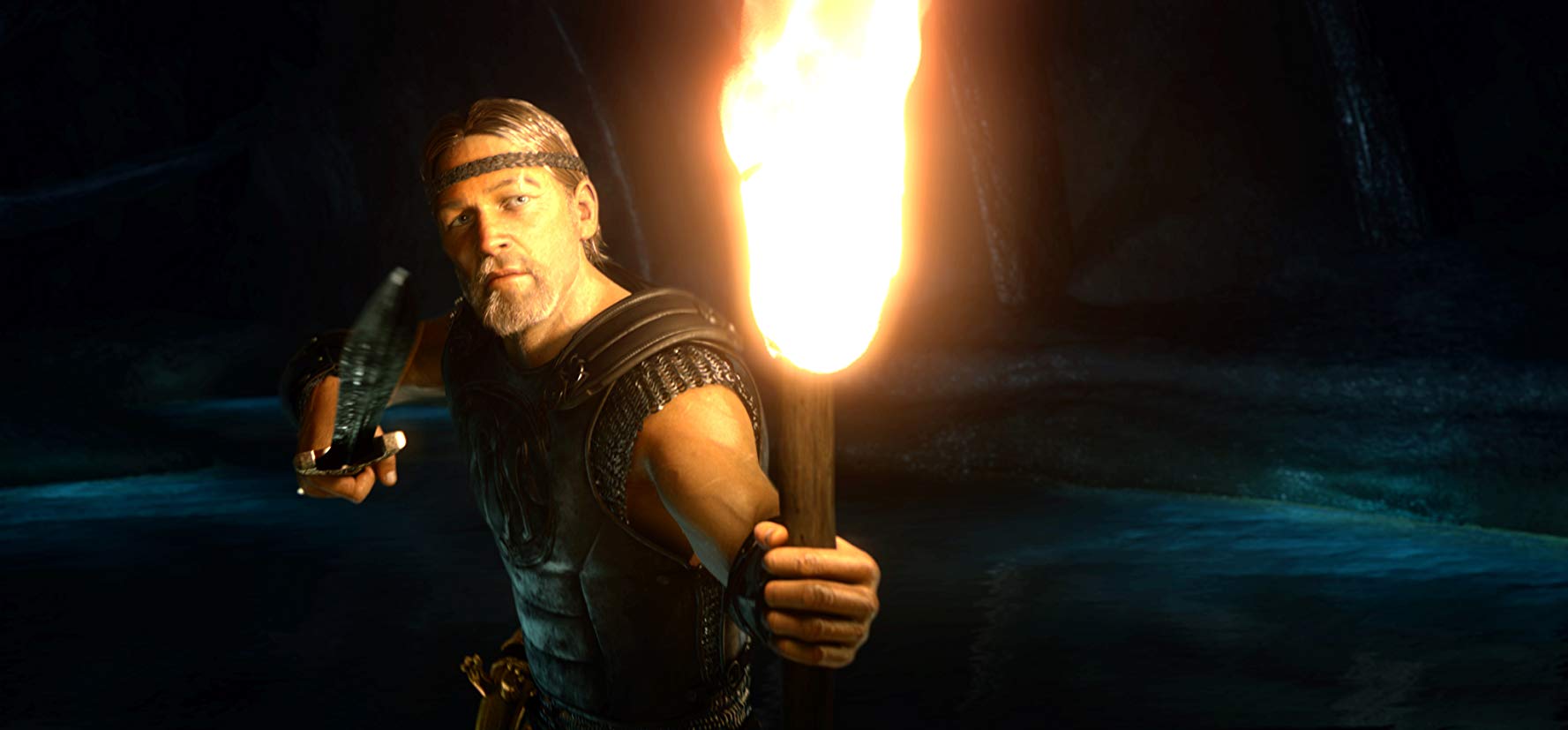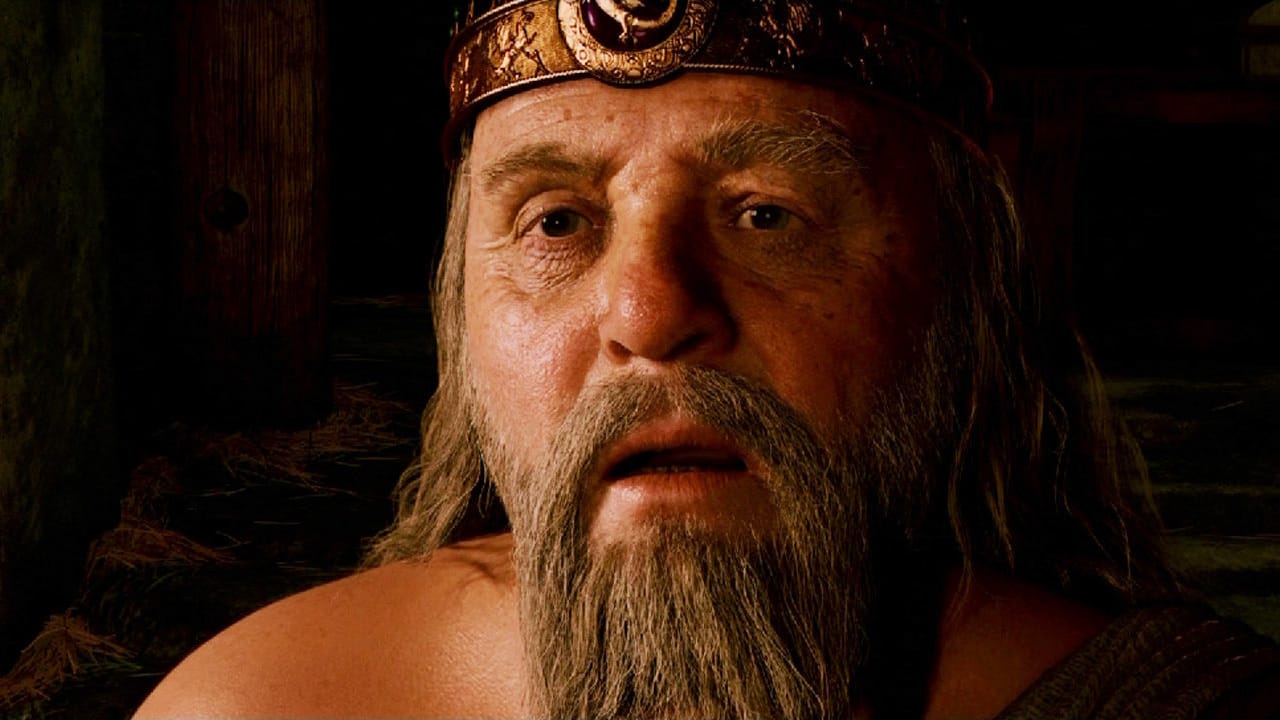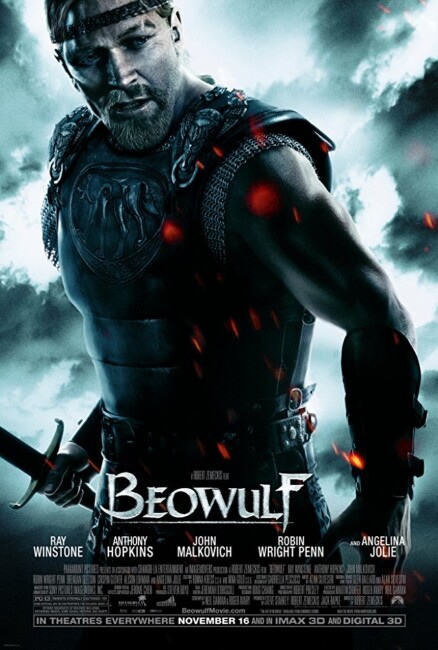USA. 2007.
Crew
Director – Robert Zemeckis, Screenplay – Roger Avary & Neil Gaiman, Based on the Poem, Producers – Jack Rapke, Steve Starkey & Robert Zemeckis, Photography – Robert Presley, Music – Alan Silvestri, Visual Effects/Animation – Sony Pictures Imageworks (Senior Supervisor – Jerome Chen, Digital Supervisor – Sean Phillips, Animation Supervisor – Kenn McDonald), 3D Animation – Imageworks 3D (Supervisor – Rob Engle), Special Effects Supervisor – Michael Lantieri, Production Design – Doug Chiang. Production Company – Shangri-La Entertainment/ImageMovers.
Cast
Ray Winstone (Beowulf), Anthony Hopkins (King Hrothgar), Angelina Jolie (Grendel’s Mother), Robin Wright Penn (Queen Wealthow), John Malkovich (Unfreth), Brendan Gleeson (Wiglaf), Crispin Glover (Grendel), Alison Lohman (Ursula)
Plot
Denmark, 507 A.D. King Hrothgar opens a mighty mead hall for his warriors and names it Heorot. Their revelling awakens the monster Grendel, which bursts in and slaughters all of King Hrothgar’s warriors. The Geat warrior Beowulf arrives in answer to Hrothgar’s call for a hero. As his men settle into Heorot, Beowulf strips off his armour and faces Grendel naked in hand-to-hand combat, managing to tear off its arm and sending it fleeing to its death. He is claimed a great hero by the Danes. However, there still remains the threat of Grendel’s mother. Beowulf descends into her cavern lair to confront her. There she appears to Beowulf in seductive human form, offering to make him king if he will surrender and give her another son to replace the one he killed.
Beowulf, a verse poem written in Old English, is one of the great epic works of early literature. The text’s author is unknown and the date of its writing is only roughly estimated as being somewhere between the 9th and 11th Centuries. The single original manuscript of the poem existed in private ownership for centuries and was not translated into modern language until the 19th Century. It is believed that some of the characters in Beowulf are based on real historical people and an archaeological dig in the 1980s revealed the remains of a large hall exactly where the manuscript describes Heorot as being.
For all its stature as probably the first work of heroic adventure fiction, Beowulf has been unevenly adapted to film. In fact, up until the millennium there had been no actual screen adaptations of Beowulf but peculiarly only several deconstructions of the legend, including the Australian animated film Grendel Grendel Grendel (1981) based on John Gardner’s novel, which retells the story from the point-of-view of Grendel; the Troma film Beware: Children at Play (1989) where the leader of a group of killer children believes himself to reincarnation of Grendel and the epic plays out in modern day; the Star Trek: Voyager episode Heroes and Demons (1995), which turned the story into a holodeck simulation; Beowulf (1999), which relocated the story to a world that was a peculiar mix of Mediaeval and post-holocaust; and The 13th Warrior (1999) based on Michael Crichton’s novel Eaters of the Dead (1976), which rationalises the story as an encounter between Viking warriors and Grendel who is a surviving Neanderthal.
The 00s however saw a sudden crop of Beowulf adaptations with Sturlar Gunnarsson’s Beowulf & Grendel (2005), which attempted a realistic quasi-historical telling of the story; Grendel (2006), an adaptation for The Sci-Fi Channel; the low-budget Beowulf: Prince of the Geats (2007); this big-budget animated version; Outlander (2008), which told the story in science-fiction terms with Grendel as an alien monster; and the British tv mini-series Beowulf: Return to the Shieldlands (2016).

This version of Beowulf comes from Robert Zemeckis, an A-list director who has been responsible for films such as Back to the Future (1985), Who Framed Roger Rabbit? (1988), Forrest Gump (1994), Contact (1997) and The Polar Express (2004) among others (see below). With each film that he makes, Robert Zemeckis seems to try to push an envelope in terms of on-screen technology – Roger Rabbit blended animation and live-action in amazing ways; Death Becomes Her (1992) was one of the first films to jump aboard the CGI revolution; both Forrest Gump and to a lesser extent Contact digitally merged film and newsreel footage; The Polar Express popularised the technology of performance capture where actors were filmed wearing suits with sensors on them that translate movement into digital points in a computer environment, which were then manipulated to create a finished product that is somewhere between live-action and animation; while Beowulf expands the performance capture animation process and was released in 3D (alas not in the city where I live). Outside of his fascination with film technology, Robert Zemeckis is a fine dramatist who has created a body of work that is squarely pitched to commercial mass appeal but also remains intelligent and solidly satisfying dramatically.
To adapt Beowulf, Zemeckis has retained the services of an impressive duo of writers. First up there is fantasy writer Neil Gaiman, who became a cult figure with the celebrated graphic novel series The Sandman (1989-96) and subsequent works like The Books of Magic (1990-1), The Tragical Comedy or Comical Tragedy of Mr Punch (1994) and Marvel 1602 (2003). Gaiman has also written a number of novels beginning with the non-fiction Ghastly Beyond Belief (1985), which published a selection of bad prose from science-fiction literature; Good Omens (1990) co-written with Terry Pratchett, which satirises End Times/Anti-Christ themes; and solo fantasy novels such as Stardust (1998), American Gods (2001), Coraline (2002), Anansi Boys (2005), Interzone (2007), The Graveyard Book (2008), Odd and the Frost Giants (2008) and The Ocean at the End of the Lane (20130, as well as several children’s books. In the last few years, Gaiman has suddenly become discovered by filmmakers with works such as the tv mini-series Neverwhere (1996), the English-language screenplay for Princess Mononoke (1997), MirrorMask (2005), Stardust (2007), Coraline (2009), How to Talk to Girls at Parties (2017), the tv series American Gods (2017-21), the tv mini-series Good Omens (2019) and the tv series The Sandman (2022- ). Neil Gaiman’s co-writer is Roger Avary, a former Quentin Tarantino associate who wrote background dialogue for Reservoir Dogs (1992) and was co-writer on Pulp Fiction (1994), before Tarantino exec produced his directorial debut with Killing Zoe (1994). Avary went on to direct the modernised Frankenstein film Mr. Stitch (1995) and the non-genre likes of The Rules of Attraction (2002), Glitterati (2004) and Glamorama (2006), as well as wrote the script for the videogame adaptation Silent Hill (2006).
Neil Gaiman and Roger Avary take considerable liberties with the original text of Beowulf, something that had classics scholars up in arms. One of the most substantial changes comes in their creating a series of inter-connections between most of the principal characters – Grendel becomes King Hrothgar’s bastard son; Beowulf inherits Hrothgar’s kingdom (rather than earns his own) and marries Queen Wealthow after Hrothgar’s death; while Beowulf also sires to Grendel’s mother the dragon that he combats in the last third of the original story. None of these connections exist in the original text. The poem does not give too many details about the appearance of either Grendel or his mother so perhaps her incarnation here as a slinkily seductive Angelina Jolie can be seen an acceptable dramatic licence – on the other hand, there is nothing in the original story about either Beowulf or Hrothgar sleeping with her, in fact of Beowulf doing anything much other than killing her (which he singularly fails to do here).

You have to complement Neil Gaiman and Roger Avary as they make Beowulf 2007 the only film version to date to retain the last section of the original poem, which takes place many years later with Beowulf now an old man defending his kingdom from a dragon and losing his life in doing so. Most film versions dump this last third as it is largely not related to the bulk of the earlier part of the story concerning Grendel and mother. On a subtler level, Gaiman and Avery have changed the relationship with Grendel’s mother in an attempt to portray Beowulf as a more classical flawed hero and give him something that approaches a psychological journey, whereas the original Beowulf tended to a standard heroic cutout without any moral ambiguity. Certainly, they have done an ingenious job in knitting the story together much more closely. Moreover, they write some stirring passages that delve into the soul of heroism – there is a particularly strong sequence later in the film where Beowulf stands up to a Frisian invader who has come, hoping to kill him.
On the other hand, this does create an abrupt change at about the two-thirds point of the film where Beowulf returns from his confrontation with Grendel’s mother and what happened there is left hanging. As gradually becomes apparent, Beowulf has made a pact with Grendel’s mother to become king and has lied to the others about killing her. This suddenly takes what up until that point has been a heroic adventure off at a complete tangent – not just in terms of plotting and adherence to the original but also in terms of moral ambiguity. The effect is akin to Aragorn deciding to cut a deal with Sauron halfway through The Lord of the Rings or John McClane suddenly deciding to pitch in with the terrorists two-thirds of the way through Die Hard (1988). Robert Zemeckis certainly mounts to a rousing and exciting climax but even then the film goes out on a decidedly downbeat note that leaves us unsure whether Beowulf’s successor Wiglaf is going to succumb to Grendel’s mother as well.
Zemeckis, Gaiman and Avary’s version makes for interesting comparison to the recent Beowulf & Grendel. Both films approach the legend from almost opposing extremes. While Robert Zemeckis determines to make an epic fantasy, director Sturlar Gunnarsson chose to shoot his version in live-action and play down the fantastical element to deliver Beowulf more as an historical epic. Nevertheless, there are a number of similarities between the two films – particularly in the revision of Grendel as a creature that has been outcast by the Dane society and exists as a figure of repressed guilt for King Hrothgar. For the anonymous author of the original manuscript of Beowulf, Grendel was pure and uncomplicatedly evil; for both of these film versions however, Grendel is more of a pitiable outcast from society. In both films, more modern issues – social prejudice, moral compromise and devil’s bargains – take over from what was originally a straightforward story about a hero confronting a monster and write a different end message. Both films also pointedly add an historic context and set themselves on the cusp between the point that European civilization moved from paganism and was colonized by Christianity with Beowulf here having a speech about how Christianity means the death of the age of heroes.

With Robert Zemeckis you can be guaranteed of both a commercial mainstream director who creates big-budget films that impress in both their intelligence and big dramatic strokes. On most counts, Beowulf is expertly accomplished entertainment. Zemeckis stages enthralling action scenes – the initial fight between Beowulf and Grendel is a real knockdown, drag-out kicker that immediately pumps the adrenalin up into high gear. The journey down into the cave to meet Beowulf’s mother is a beautiful piece of scene setting, while the climactic fight with the dragon is magnificently exhilarating. Robert Zemeckis also makes Beowulf a surprisingly adult film – the confrontations with Grendel are frequently violent with scenes of it shedding blood and biting the heads off warriors, while there is also a degree of bawdy humour that runs throughout the film, not to mention appearances from an (animated) naked Angelina Jolie and Beowulf fighting Grendel starkers. (One of the more amusing aspects of the film is watching the animators having to conduct a rather absurd series of Austin Powers-type contortions in order to have various objects hiding Beowulf’s genitalia during these scenes).
Robert Zemeckis has peopled Beowulf with a number of well-known faces and the animators model most of the characters on the likeness of the actors. Both Anthony Hopkins and Angelina Jolie have clear fun with their roles. Ray Winstone is less recognizable, with the animators having built Winstone’s more rotund build up into something muscularly buffed. (There is something incongruous about hearing Ray Winstone’s distinctive rough-hewn East London accent coming from the mouth of Beowulf who you never imagined talking like a hood from a Guy Ritchie film). There is still a certain blankness to the animation – the characters’ eyes just don’t look natural. There are times you feel that you are in the midst of Beowulf the High Resolution Computer Game more than an animated film, but the background of the film is drawn with a richness and attention to detail and there are some images of exquisite beauty.
Beowulf was parodied in Disaster Movie (2008).
Robert Zemeckis went onto make a further performance capture animated film with A Christmas Carol (2009), also shot in the Real-D 3D process, while he has also produced Monster House (2006) and Mars Needs Moms (2011) in the same process.
Robert Zemeckis’s other films as director are:– I Wanna Hold Your Hand (1978), Used Cars (1980), Romancing the Stone (1984); his time travel trilogy Back to the Future (1985), Back to the Future Part II (1989) and Back to the Future Part III (1990), Who Framed Roger Rabbit? (1988), Death Becomes Her (1992), Forrest Gump (1994), the alien contact film Contact (1997), What Lies Beneath (2000), Cast Away (2000), Flight (2012), Allied (2016), Welcome to Marwen (2018), The Witches (2020) and Pinocchio (2022). Zemeckis has also produced a large number of other genre films including the Tales from the Crypt (1989-96) cable tv horror anthology series, the two film spinoffs Tales from the Crypt Presents Demon Knight (1995) and Tales from the Crypt Presents Bordello of Blood (1996), Peter Jackson’s The Frighteners (1996), the voodoo film Ritual (2002), the animated Monster House (2006) and Mars Needs Moms (2011), the boxing robots film Real Steel (2011), the tv series’ Manifest (2018-22) about a planeload of temporally displaced passengers and Project Blue Book (2019-20) about the US Air Force’s true life UFO investigation department and the robot film Finch (2021). Zemeckis is one of the producing partners in Dark Castle Entertainment and under their banner has acted as producer for House on Haunted Hill (1999), Thir13en Ghosts (2001), Ghost Ship (2002), Gothika (2003), House of Wax (2005) and The Reaping (2007).
Trailer here

